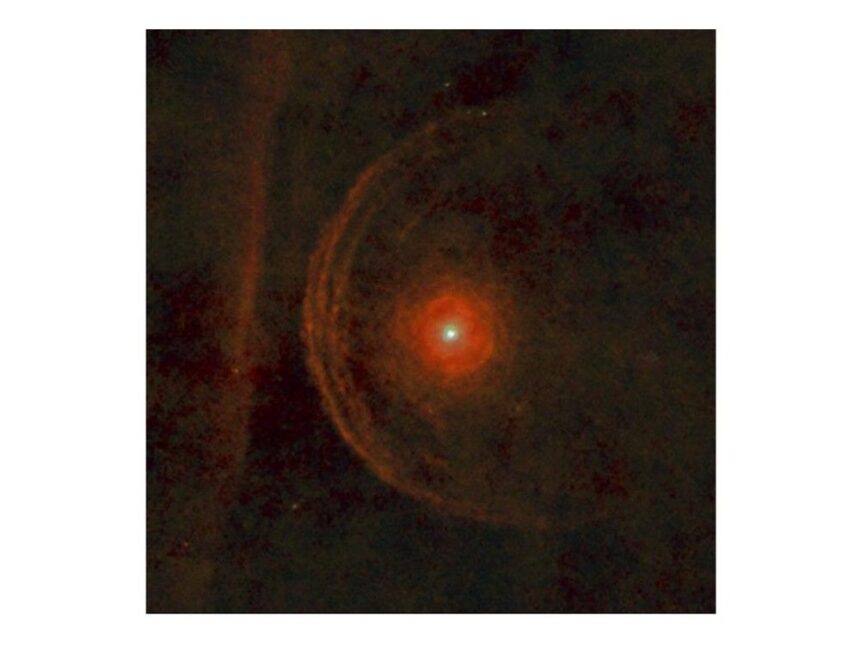As-yet-unnamed companion believed to have formed about the same time as Betelgeuse about 10 million years agoPublished Jul 31, 2025Last updated 10 hours ago8 minute readThe red supergiant star Betelgeuse center is surrounded by a clumpy envelope of material in its immediate vicinity in this view from the Herschel Space Observatory. ESA/Herschel/PACS/L. Decin et al.Article contentFor over 100 years, astronomers have speculated that the red supergiant star Betelgeuse has a small companion star. THIS CONTENT IS RESERVED FOR SUBSCRIBERS ONLY.Subscribe now to access this story and more:Unlimited access to the website and appExclusive access to premium content, newsletters and podcastsFull access to the e-Edition app, an electronic replica of the print edition that you can share, download and comment onEnjoy insights and behind-the-scenes analysis from our award-winning journalistsSupport local journalists and the next generation of journalistsSUBSCRIBE TO UNLOCK MORE ARTICLES.Subscribe or sign in to your account to continue your reading experience.Unlimited access to the website and appExclusive access to premium content, newsletters and podcastsFull access to the e-Edition app, an electronic replica of the print edition that you can share, download and comment onEnjoy insights and behind-the-scenes analysis from our award-winning journalistsSupport local journalists and the next generation of journalistsRegister to unlock more articles.Create an account or sign in to continue your reading experience.Access additional stories every monthShare your thoughts and join the conversation in our commenting communityGet email updates from your favourite authorsSign In or Create an AccountorArticle contentOn July 21, 2025, it was announced that a small, faint companion star to Betelgeuse had actually been discovered. It was found using the 8.1-metre diameter ‘Alopeke (Hawaiian for fox) instrument on the Gemini North telescope at the International Gemini Observatory located atop the Mauna Kea volcano in Hawaii. Article contentArticle contentArticle contentUtilizing a technique referred to as “speckle imaging” (a range of high-resolution astronomical imaging techniques that analyze a large number of short photographic exposures that freeze the variations in the distortions in Earth’s turbulent atmosphere), astronomers at the International Gemini Observatory were able to produce a high-resolution image of Betelgeuse’s tiny companion star. It has been calculated to be six times fainter than Betelgeuse, and to be orbiting just within the extended outermost atmosphere of its larger cohort. Article contentHow did Betelgeuse get its name?Article contentBetelgeuse is the famous orange-red supergiant star in the upper left-hand corner of the constellation of Orion – the Hunter, as viewed from Earth. Article contentIn many ancient mythologies, Orion was seen as a hero, a giant, a hunter, a god, and, upon occasion, represented with anthropomorphic or animal figures. The term “Betelgeuse” itself translates from the Arabic phrase, “The Armpit of the Giant,” although, in modern-day references, it is seen as representing the Hunter’s right shoulder, above which he wields his huge club. Article contentArticle contentBetelgeuse, due to its distinctive colour and brightness, is well known to many global cultures. Article contentArticle contentIn Brazil, it is viewed, somewhat less grandly, as the hind leg of a caiman (a crocodilian) or the foreleg of a turtle. In ancient Japan, it was considered part of the rim of a ceremonial drum, while in Peru it was one of four vultures about to devour a criminal. Article contentIt is the 10th brightest star in the sky, and the seventh brightest in the Northern Hemisphere sky. It is also the closest red supergiant star to Earth, and the nearest potential supernova. Article contentWhy does Betelgeuse dim and brighten?Article contentThe constellation of Orion, radiant in the night sky throughout the late autumn and winter months, can now be seen rising in the pre-dawn eastern sky in early August. Article contentBetelgeuse, located at approximately 640 to 750 million light-years from Earth, is what is referred to as a semiregular variable star, having an apparent magnitude that varies between +0.0 and +1.6 on a regular timeframe of approximately 400 days. This semiregular dimming and brightening of Betelgeuse, the most recent having occurred in 2024, has led some astronomers to speculate that it will explode as a supernova fairly soon. Article contentWhen it does go supernova, Betelgeuse is expected to get as bright as a full moon, and to possibly be visible during the day. Article contentHow will Betelgeuse eventually collapse?Article contentMassive stars such as Betelgeuse burn enormous amounts of nuclear fuel (in the form of hydrogen) at a very rapid rate. This burning generates enormous amounts of energy and heat. Article contentAs the star heats up, its outer layers expand outward and cool, giving the star its reddish colour and its name – red supergiant. When the massive star uses up all of its core’s hydrogen fuel, the balance between the outward pressure generated by the burning of the star’s nuclear fuel, and the inward pressure due to gravity (a product of the star’s mass) can no longer be maintained; gravity gets the upper-hand, and the star collapses in on itself, typically at such a rapid rate that massive shock waves are generated, causing the star’s outer layers to explode violently as a supernova, usually leaving a dense stellar core surrounded by radiating clouds of dust and gas referred to as nebulae. Article contentArticle content This frame from an animation shows a kind of stellar explosion called a Fast-Evolving Luminous Transient. In this case, a giant star “burps” out a shell of gas and dust about a year before exploding. Most of the energy from the supernova turns into light when it hits this previously ejected material, resulting in a short, but brilliant burst of radiation. NASA/JPL-CaltechArticle contentWhen the ‘red supergiant’ may go supernova is anyone’s guess Article contentAlthough astronomers cannot accurately assess at just what stage in its stellar evolution Betelgeuse is, indications are that it is in a late core carbon-burning stage. Article contentBased on stellar evolution models of massive stars, this stage typically precedes a supernova explosion, thereby possibly signaling that Betelgeuse may be approaching the end of its life. Article contentHowever, as the core carbon-burning phase for a star having the mass of Betelgeuse (estimated at approximately 20 times the mass of our Sun) typically takes approximately 1,000 years, exactly when Betelgeuse will go supernova is, at this point in time, merely conjecture; it could be tomorrow, next month, next year, or not for hundreds of years yet. Article contentFor an enlightening and in-depth article on the rhythmic dimming and brightening of Betelgeuse, and what it means with respect to its lifespan, read the June 1, 2023 article titled “The evolutionary stage of Betelgeuse inferred from its pulsation periods” at arxiv.org/abs/2306.00287; click on the “Access Paper” and then “View PDF” in the upper right hand corner of the page to view and read the entire article. Article contentArticle contentWhat does the future hold for Betelgeuse’s companion star?Article contentThe as-yet-unnamed companion star to Betelgeuse is believed to have formed about the same time as Betelgeuse, approximately 10 million years ago. Article contentIt is blue-white in colour, signifying that it is a young, hot star that is most likely still forming, having not yet commenced hydrogen-burning in its core. It has an estimated mass of approximately 1.5 times that of our Sun, not enough to one day explode as a supernova like Betelgeuse. Article contentIt is, however, not likely to get very much older, as astronomers surmise that it will probably be consumed by Betelgeuse. Article contentThe discovery of Betelgeuse’s companion is a significant step forward in the understanding of the dynamic relationships and processes of red supergiant binary systems (a stellar system composed of a red supergiant and another, usually smaller and fainter, star). Article contentThe data collected from continued observations by telescopes such as the Gemini North telescope, and the soon-to-be-fully-operational Vera Rubin Observatory’s LSST, combined with technological advancements such as “speckle imaging,” will help astronomers refine existing stellar modeling and predictions concerning how red supergiant stars behave when they have stellar companions. Article contentUpcoming viewing times for planets in our solar systemArticle contentMercury (mag. +4.3, in Cancer – the Crab), having recently passed in front of the Sun (inferior solar conjunction), is not observable this coming week, as it is 12 degrees (1 degree on Aug. 10) below the eastern horizon at dawn. Venus (mag. -4.0, in Gemini – the Twins), visible in the dawn sky as the “morning star,” rises in the east-northeast around 2:55 a.m. ADT, reaching 25 degrees (also 25 degrees on Aug. 10) above the eastern horizon before fading from view into the brightening dawn by about 5:35 a.m. ADT. On the morning of Aug. 7, Venus reaches its highest morning sky altitude of 29 degrees at sunrise. On the morning of Aug. 10, Venus and Jupiter will be in close conjunction with one another in the pre-dawn east-northeast sky; Jupiter will be to the left, with brighter Venus to the right. Mars (mag. +1.6, in Leo – the Lion), now receding into the evening twilight, is not observable this coming week, as it is no higher than 7 degrees (6 degrees on Aug. 10) above the western horizon at dusk. Jupiter (mag. -1.9, in Gemini – the Twins), visible in the dawn sky, rises in the east around 3:20 a.m. ADT, reaching 19 degrees (24 degrees on Aug. 10) above the eastern horizon before fading from view in the brightening dawn around 5:35 a.m. ADT. Saturn (mag. +0.9, in Pisces – the Fish), becomes accessible by about 11:40 p.m. ADT, when it reaches 11 degrees (also 11 degrees on Aug. 10) above the eastern horizon before fading into the dawn twilight just as it reaches its highest point in the sky 42 degrees (41 degrees on Aug. 10) above the southern horizon by around 5:10 a.m. ADT. Uranus (mag. +5.8, in Taurus) rises in the east around 12:40 a.m. ADT, reaching 37 degrees (43 degrees on Aug. 10) above the eastern horizon before fading with the approaching dawn around 4:30 a.m. ADT. Neptune (mag. +7.9, in Pisces), becomes accessible when it reaches 21 degrees (also 21 degrees on Aug. 10) above the southeast horizon around 12:40 a.m. ADT, reaching its highest point in the sky 43 degrees (also 43 degrees on Aug.10) above the southern horizon before fading from view in the dawn twilight by about 4:30 a.m. ADT. On the morning of Aug. 10, Saturn and Neptune will be in close conjunction with one another in the pre-dawn southeast sky; Saturn will be visible to the naked eye, but Neptune will require binoculars or a telescope. Article contentArticle contentWhen will we see the next ‘supermoon’?Article contentThe full “Sturgeon Moon” on Aug. 9 gets its name from the Indigenous Algonquin peoples living in the Great Lakes region, as they knew this was the best time of the season to catch large sturgeon (fish) in the lakes. Article content The Moon, or supermoon, is seen as it rises behind the U.S. Capitol, Monday, March 9, 2020, in Washington, DC. A supermoon occurs when the Moon’s orbit is closet (perigee) to Earth. Photo by NASA/Joel Kowsky /NASA/Joel KowskyArticle contentIncidentally, as this Full Moon comes just days before the Moon reaches perigee (its closest approach to Earth) on Aug. 14, it will appear approximately 14 per cent bigger and about 30 per cent brighter than a regular Full Moon, and, as such, is sometimes referred to as a “supermoon.” It should be noted, however, that these changes in size and brightness will not be readily obvious to most observers. Article contentPerseid meteor showers to peak on Aug. 11-12Article contentRemember to watch for Perseid meteors streaking across the night sky (any time after 10 p.m. ADT) from the northeast on any clear night once the sky has darkened in the coming days. Article content In this 30 second exposure, a meteor streaks across the sky during the annual Perseid meteor shower, Wednesday, Aug. 11, 2021, in Spruce Knob, West Virginia. Photo by NASA/Bill Ingalls /NASA/Bill IngallsArticle contentThis famous meteor shower, whose radiant (its apparent point of origin) is in the constellation of Perseus – the Prince (thus its name), will peak during the overnight period of Aug. 11-12. More about the Perseids in next week’s article. Article contentUntil next week, clear skies. Article contentEvents: Article contentAug. 7 – Venus reaches its highest morning sky altitude (29 degrees) at sunrise Article contentAug. 9 – Full “Sturgeon Moon” Article contentAug. 10 – Saturn and Neptune in close conjunction in pre-dawn southeast sky Article contentAug. 10 – Venus and Jupiter in close conjunction in pre-dawn east-northeast sky Article content
ATLANTIC SKIES: It’s official, Betelgeuse has a stellar companion











